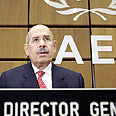
The chief UN nuclear inspector said Thursday that his agency's Syria probe has been hampered because key satellite images of an alleged nuclear reactor bombed by Israel are inexplicably unavailable on the market.
But diplomats familiar with the IAEA's Syria investigation said agency officials were considering several scenarios, including the possibility that Syria or other nations with an interest in a cover-up had bought the photos and all rights to them from commercial satellite companies.
ElBaradei's comments at the start of a two-day full meeting of the IAEA's 35-nation board partially reflected the focus of the gathering - suspicions about Syria's and Iran's nuclear activities.
On Iran, ElBaradei told the meeting that he "cannot exclude the existence of possible military dimensions to Iran's nuclear program."
The US and the European Union both expressed alarm at Tehran's defiance of UN Security Council resolutions meant to curb its suspected nuclear activities. And Ali Ashgar Soltanieh, Iran's IAEA representative, accused Washington and its allies of dragging it before the Security Council as part of a "hidden agenda."
In the case of Syria, ElBaradei noted that his "agency was unable to obtain commercial satellite imagery" of the site immediately after the bombing, adding: "It is regrettable, and indeed baffling, that imagery for this critical period... was not available."
Syria slams theory as 'nonsense'
Syrian nuclear chief Ibrahim Othman was dismissive, telling the Associated Press: "The theory that we bought all the photos is nonsense."
The IAEA often turns to commercial images beyond any spy satellite photos shared by governments. But the two nations most likely to have satellite intelligence were unlikely to have provided it with immediate information.
Israel still has not confirmed it was behind the strike, while the United States waited for more than six months before sharing knowledge with the IAEA.
The possibility that commercial companies simply did not know where to look immediately after the bombing was raised by David Albright, whose Washington-based Institute for Science and International Security closely tracks suspected secret proliferators.
"The United States and Israel went to great lengths to prevent others from finding out where the site was," said Albright, whose institute was the first to publish commercial satellite images of the site more than a year ago and identify it as a likely North-Korean-model nuclear reactor.
"No one knew where the site was immediately after the bombing," said Albright, whose institute published photos taken nearly a month before the Sept. 6, 2007, Israeli strike.
Albright also noted that ElBaradei was initially skeptical of the US assertions, which could have led to Washington and Israel to withhold satellite photos.
"Why would US Intelligence give photos to ElBaradei if he was predisposed not to believe" that they showed a secret nuclear reactor, Albright said in an interview.
'ElBaradei comments out of date'
Meanwhile, a senior diplomat familiar with the Syria probe suggested that the comments by ElBaradei were at least partially out of date. He said the agency had "very recently" been able to locate commercial images showing the site after the Israeli strike.
IAEA spokeswoman Melissa Fleming said the agency would not comment on the issue. All of the diplomats asked for anonymity in exchange for speaking to the Associated Press because their information was privileged.
While the agency was unable to find satellite images immediately after the bombing, it acquired photos showing the building at other stages. An IAEA report said those images and other information showed the bombed building had the features of a reactor, adding that agency inspectors had found traces of processed uranium on location.
The US says the target was a nearly completed reactor that would have produced plutonium, a possible fissile warhead component. Syria has signaled it will not permit IAEA inspectors to return to the country after their initial visit to the bombed site in June, or permit initial visits to three other suspicious locations. Such a ban would make satellite images become even more important in the IAEA probe.















